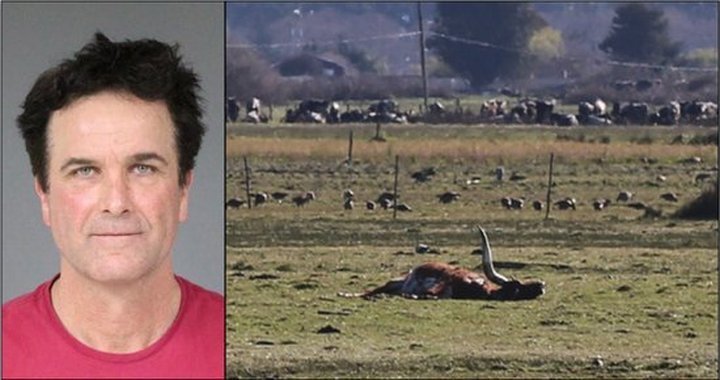
Regardless
of whether jurors vote to convict or acquit Arcata rancher Ray
Christie, it’s possible the meat-eaters on the panel could become
vegetarians.
Most of the evidence presented Monday against Christie, accused of animal cruelty and littering within 150 feet of state waters, consisted of photographs of decaying cattle carcasses and piles of bones. Some of the remains were near waterways, others were rotting in the water itself.
Ryan Bourque, an environmental specialist with the California Department of Fish and Wildlife, was assigned to document the alleged littering by photographing carcasses and measuring their distance from waterways. His first stop was a ranch on Jackson Ranch Road, where Christie lives and where most of the dead cattle were found. Bourque’s most notable find was the stack of carcasses — he estimated 200 — about 100 feet from a water channel that drains into Liscomb Slough.
“I attempted to (count),” Bourque testified under questioning by Deputy District Attorney Adrian Kamada. “But the sheer number of them, the fact that they were piled on top of each other, that they were in various stages of decay…”
Kamada displayed photos of the many carcasses, along with maps of the properties. Bourque would mark on a map the various “pollution points” he discovered.
Under cross-examination by defense attorney John Cogorno, Bourque spent most of his time responding “No,” “I don’t know” and “I did not.”
Cogorno, while occasionally varying his wording, asked countless times whether Bourque knew how the carcasses got there, knew how the animals died, knew when they died, knew who owned the animals. Kamada objected often on grounds of “asked and answered” or “irrelevant.”
Most of the time Judge Christopher Wilson sustained those objections.
Bourque did not take water samples in the areas where the carcasses were found, saying that’s not why he was there.
During his cross-examination, Cogorno suggested one of the cows might have been killed by a wild animal. He also brought up poisonous plants, which he maintains could have been a cause of death.
The large pile of dead animals on Christie’s Arcata ranch may have been stacked on some sort of bench or high point on the property, Cogoran said, which may explain why the stack was so high. Bourque said he saw no evidence of a natural ledge but admitted he didn’t know what was under the pile.
In addition to the Jackson Ranch Road properties, law enforcement served search warrants on Clam Beach Road in McKinleyville, Anderson Avenue in McKinleyville, property off Park Street in Eureka, property in Crannell and property off South G Street in Arcata. Christie either owned or leased the various parcels.
Christie, 56, was arrested during the raids on March 19 and March 20, 2018, but immediately posted bail.
On Friday, outside the jury’s presence, Kamada and co-prosecutor David Moutrie told Wilson they believe Christie also removed official identification tags from cattle he purchased at auction as part of a scheme to disguise conventional cows as “organic.”
Wilson did not allow that in as evidence, saying it was a conclusion and not a fact.
Deputy Travis Mendes, the livestock and “ag crimes” deputy for Humboldt County, testified today that he removed a bucket from Christie’s barn that contained “just under 1,300” identification tags.
Prosecutors allege Christie bought the animals, then proceeded to distribute them on his properties and leave them to starve. The defense says Christie bought sub-par animals intending to restore them to health, and it was no surprise that some of them died.
Testimony was expected to continue this morning.
###
PREVIOUSLY:
- Cops Raid Notorious Ranch in the Arcata Bottoms; Rancher Ray Christie Arrested at the Scene
- More Than 250 Dead Cows Found on Ray Christie’s Properties, Says HCSO; Numerous Other Alleged Violations Discovered
- Humboldt-Del Norte Cattlemen’s Association Calls Ray Christie’s Ranch ‘Horrific,’ Says Anyone Convicted of Animal Abuse Should be Punished to the ‘Greatest Extent Possible’
- Judge Says Ray Christie, Arcata Rancher Accused of Animal Cruelty, Can Still Own Livestock For Now
- OP-ED: Ban Rancher Ray Christie from ‘Caring’ for Animals
- Rancher Ray Christie Held to Answer for Three Felony Charges of Animal Abuse; Four Charges Dropped After Investigating Deputy’s Testimony Was Compromised
- Arraignment for Accused Animal Abuser Ray Christie Postponed; Goose Still in Custody
- Judge Reverses Own Decision in Christie Animal Cruelty Case; Arraignment Set For Next Month
- CRASH, BANG, BUSTED! Here Are the Top 25 Lost Coast Outpost Posts of 2018, as Measured by Site Traffic
- Calling State Law ‘Unconstitutional,’ Attorneys for Rancher Ray Christie Ask Judge to Throw Out Case Involving Hundreds of Cattle Carcasses Found on His Land
- Ray Christie’s Lawyer Says: First They Came For Ray Christie, and You Did Not Speak Out Because You are a Vegetarian
- CHRISTIE CASE: Judge Denies Defense Motion; Rules That Case Against Rancher Accused of Animal Cruelty, Cattle Corpse-Dumping May Proceed
- TODAY in COURT: Trial of Rancher Raymond Christie Set to Start Later This Month; Torture, Murder Suspect Declines to Show for Hearing
- ‘Nothing But a Show’ Rancher Ray Christie’s Attorney Says After Jury Shown Images of Numerous Dead or Dying Cows
- CHRISTIE TRIAL: Defense Attorney Attacks Investigating Deputy’s Credibility
- CHRISTIE TRIAL: Prosecutors Allege Rancher Illegally Removed Tags From Cattle to Pass Them Off as ‘Organic’
CLICK TO MANAGE